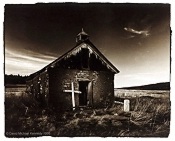
San Isidro, 1997 - In March of 1997, Kennedy photographed the church of San Isidro near Manuelitas, NM. Built in 1900, the stone and mud plaster church was abandoned about twenty years ago and is currently in danger of total collapse. Kennedy photographed the front of the church in the "quiet-light" after sunset, focusing on a broken white cross leaning against the crumbling adobe wall.
The church's small belfry stands out against cloudy skies while tall grasses bend in the unkept fields. Kennedy's photograph clearly shows that without immediate restoration this church will soon be in ruins. Yet, the church's solid proportions and its erect, if broken cross, convey the essence of old world Catholicism steeped in mystery and the transience of all earthly things.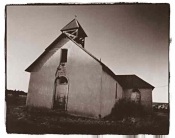
Nuestra Senora de Guadalupe, 1997 - Located near Las Vegas, NM, the church of Nuestra Senora de Guadalupe built around 1904, is still used once a year by local people. Constructed of stone and topped with a corrugated tin roof, the building is more intact than many its age. Photographed in twilight the church appears luminous, suggesting something eternal, as if its spiritual essence will outlive its physical destruction.

Holy Ghost, 1997 - In April Kennedy tracked down the Holy Ghost church in a Colfax County ghost town north of Springer. Guided by a photograph taken in the early 1970s that showed the church partially standing, Kennedy arrived to find a pile of rubble on the ground with three corners resembling broken chimneys punctuating an otherwise empty landscape. Kennedy included the parallel lines of highwire, and a wood post fence in his photograph to emphasize the desolate nature of the place. The image is a sad but eloquent reminder about how fragile these ancient structures are.
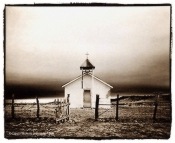
San Isidro, Tinaja 1997 - South of Raton in Colfax County, Kennedy photographed a Spanish church constructed in the 1920s. Used once a year the church is still sound, but in need of maintenance. A fierce wind storm was raging that day and its turbulent atmosphere infuses the photograph with energy. The brightly lit church with its cross-topped white belfry stands out sharply against ominous storm clouds.
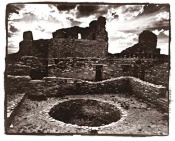
Abo, 1997 - The ruined church of San Gregorio de Abo is part of the Salinas Pueblo Missions in the Mountainair district. Consisting of three different ruins, Gran Quiivira, Quarai and Abo, the mission churches were built within Indian communities around 1620 by Spanish priests. All were abandoned shortly afterwards by the Spanish and Indians. Kennedy made a spectacular photograph of the roofless stone mission at Abo with a circular kiva in the foreground, emphasizing- the backlit clouds behind the church
PETROGLYPHS
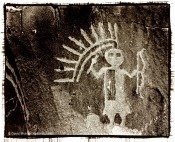
In the Largo Canyon drainage north of Chaco, Kennedy photographed three dramatic petroglyphs in an area known as the Navajo Pueblitos, capturing every crevice, crack and indentation in the rocks. Monster Slayer, 1997, is a horned shield figure, six feet tail. Horned Man, 1997, is a horned personage holding a loop. Crow Canyon Man, 1997, wears a feathered headdress and holds a bow and arrow. In an effort to defend themselves against Ute raids and the influence of Spanish missionaries, the Navajo inhabited the labyrinth of canyons from the 1600s until the mid -1700s when drought forced them to move westward, leaving behind extensive petroglyphs and ruins.
CULTURAL LANDSCAPES AND ARTIFACTS
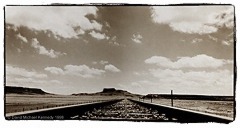
In frontier times the distinctive mesa known as Wagon Mound not only marked the journey's end for many a traveler, but was the destination for cattle drives. There, cattle were loaded onto trains and sent to other parts of the country. In Wagon Mound, 1997, Kennedy photographed the site from the ground level of railroad tracks that stretch toward a vanishing point and the familiar formation. Kennedy magnified the illusion of deep space by cropping the photograph into a narrow horizontal format.
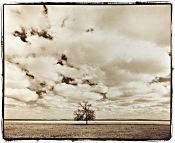
East of Las Vegas, where one of the west's most famous cattle drives once passed, Kennedy evoked The Goodnight Loving Trail, 1997. The title reminds us that once the cattle drive, like the lone tree in the photograph, was the only focal point in what is still an empty prairie.
These and other works, including the ruined church at Abiquiu, the Santa Rosa de Lima Church, the Pecos National Monument, and Fort Sumner will be on display at Andrew Smith Gallery through November 1997. From there the exhibit will travel to New York.
David Michael Kennedy moved to New Mexico from New York City in 1987. He is internationally recognized for his splendid palladium prints of southwest lands and skies, celebrities like Bob Dylan, Isaac Stern and Bruce Springsteen, and Native American Dancers from South Dakota and New Mexico. Each of Kennedy's palladium prints is made laboriously by hand. The rich brown tones of the palladium images, bordered by lively brush strokes, recall turn-of-the century sepia photographs by Edward S. Curtis and albumen prints by William Henry Jackson.
For more information, press prints, or to set up an interview with David Michael Kennedy please call Andrew Smith Gallery at (505) 984-1234, FAX (505) 983-2428. Gallery hours are Monday through Saturday 10:00 to 5:30, and Sunday 12:00 to 4:30.
Liz Kay
|
